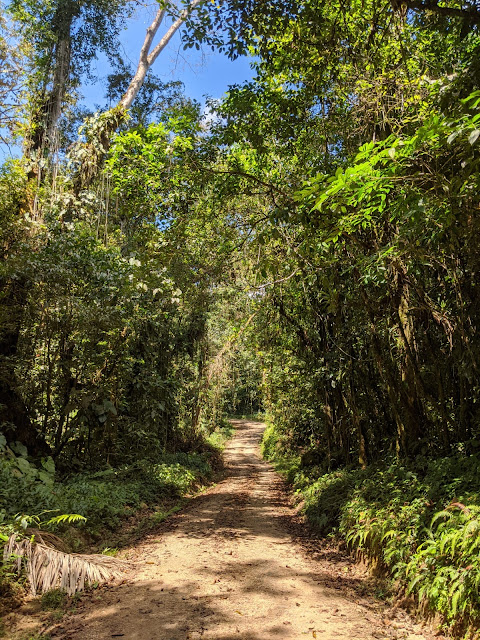Our first stop, however, was a protected forest just outside of Villavicencio called Bosque Bavaria. Ranging from around 400 m to 900 m in elevation, this reserve protects habitat for a wide range of lowland and lower foothill species.
 |
| Golden-headed Manakin - Bosque Bavaria, Meta, Colombia |
Not a lot of foreigners seem to bird this part of Colombia, and those that do are usually a part of a tour or hire a driver/guide, therefore it is often difficult to find good intel that is relevant to us (traveling independently with a rental car). I could not find much information on Bosque Bavaria including access, and I even contacted ProAves who runs the reserve. ProAves is notoriously difficult to get a hold of by email (unless you are booking at one of their very expensive lodges), and as expected, they did not get back to me after I inquired about access. Luckily my good friend Luis Urueña of Manakin Tours was happy to provide an answer. There is no entrance gate (or any infrastructure) and you can bird from the gravel road that passes through the reserve. Easy enough!
 |
| Bosque Bavaria, Meta, Colombia |
We parked our car near a small waterfall that is less than 1 km from the entrance and hiked up the gravel road, reaching the very top by late morning. The birding was pretty enjoyable and we came across a few mixed flocks. We discovered a few nice Amazonian birds like an Amazonian Umbrellabird, Masked Tanagers and a singing Black-faced Antbird - the latter two species were lifers. Green-backed Trogons were commonly heard singing, while Cobalt-winged Parakeets whizzed by overhead frequently. Hummingbirds were well represented and a Sooty-capped Hermit even fed on some flowers long enough for me to photograph it.
 |
| White-bearded Manakin - Bosque Bavaria, Meta, Colombia |
 |
| Pale-breasted Thrush - Bosque Bavaria, Meta, Colombia |
 |
| Sooty-capped Hermit - Bosque Bavaria, Meta, Colombia |
 |
| Sepia-capped Flycatcher - Bosque Bavaria, Meta, Colombia |
The colours on this young leafhopper were incredible!
The day quickly became hot and the butterflies took advantage of the sunny conditions. Here is just a small selection of some of them.
My favourite Lepidopteran of the day was not a butterfly but this tiny moth.
On our walk back down the hill to the car we found this Squirrel Cuckoo taking down a big spider.
 |
| Squirrel Cuckoo - Bosque Bavaria, Meta, Colombia |
We stopped back at the car to have lunch but the pull of the nearby waterfall was too much to resist. I stripped down and cooled off for 10 minutes and had no regrets!
Following that welcome diversion we continued hiking down the road. Laura came through once again with an excellent discovery. This time it was a young Red-footed Tortoise.
 |
| Laura and the Red-footed Tortoise - Bosque Bavaria, Meta, Colombia |
Red-footed Tortoises can grow up to 40 cm in length and are native to the northern Amazon basin. They are omnivorous but eat mostly plant matter, such as fruits and grasses, as well as fungi and carrion. While we were observing the youngster, a woman passed by and sweetly offered us two mangos. We put a few pieces in front of the tortoise and he happily gobbled them up!
 |
| Red-footed Tortoise - Bosque Bavaria, Meta, Colombia |
Like many tortoise species around the world, the Red-footed Tortoise is threatened by a combination of habitat loss and collection for the pet trade. This particular species is listed as Vulnerable by the IUCN.
 |
| Red-footed Tortoise - Bosque Bavaria, Meta, Colombia |
We left the Villavicencio area and drove east, heading for the llanos around Puerto Lopez. That will be the topic of my next post.







2 comments:
Hi
Have you found good sources like field guides for insects, reptiles etc identification? Of course, birds are "easy"
There are a number of good print resources here in Colombia, but as we are traveling light we are doing everything digital. iNaturalist has been an invaluable resource to see what species have been recorded in areas. For herps, I found that the Reptiles of Ecuador webpage is great (https://www.tropicalherping.com/science/books/reptiles/reptiles_of_ecuador.html#species_list). For some locales in Colombia, I have used the website Butterflies of Colombia ((https://www.butterfliesofcolombia.com/catalogos) which has some good pdfs. There are a lot of good online resources but they take some hunting to find.
Post a Comment